Editorial Note: This Model was produced during World War II. A war fought from 1939 to 1945 between the Axis powers (Germany, Italy, and Japan) — and the Allies, including France and Britain, and later the Soviet Union and the United States. The war began when the Germans, governed by the Nazi party, invaded Poland in September 1939. Germany then conquered France. The Soviet Union signed a treaty with Adolf Hitler but entered the war on the side of the Allies after Germany invaded Russia in 1941. The United States was drawn into the war in 1941, when the Japanese attacked at Pearl Harbor. The German invasion of Russia was halted at the Battle of Stalingrad. Allied forces took much of Italy in 1943, forcing its surrender. Beginning with the invasion of Normandy in 1944 (D-Day), the Allies liberated France from German occupation and pressed on in Europe, defeating the Germans in the Battle of the Bulge and elsewhere. Germany surrendered in May 1945 (V-E Day). The war in the Pacific ended in September 1945.
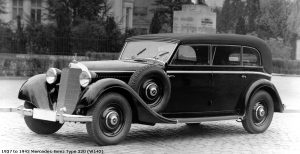
Mercedes-Benz Type 320 (W 142)
The Mercedes-Benz Type 320 (W 142 series) celebrated its premiere at the International Automobile and Motorcycle Exhibition (IAMA) in Berlin in February 1937. With it, the brand closed a gap in the market between medium-sized vehicles and vehicles of the largest format. At least, this is what the renowned “Allgemeine Automobil-Zeitung” (AAZ or “General Automotive Magazine”) felt upon the presentation of the new 3.2-litre motor car. With this model Mercedes-Benz broke new ground in this particular vehicle class, which in those days was characterised by extreme competitiveness. Its traditional strong rivals were Horch with its 930 V and 830 BL models, Opel with the newly presented Admiral model and Ford with its 3.6-litre V8.
Initially, Mercedes-Benz offered two wheelbases. For the short-wheelbase versions – 2880 millimetres – the following bodies were available:
- Chassis…………………………………………………………6,500.00 RM
- Cabriolet A…………………………………………………..11,800.00 RM
- Combination coupé with removable roof………..12,300.00 RM
However, the version with a regular chassis and a wheelbase of 3300 millimetres was the one that found the greater acceptance with customers. The following bodies were available for this variant:
- Saloon with 4 doors & 4 windows…………………..8,950.00 RM
- Cabriolet B with 2 doors & 4 windows…………….9,800.00 RM
- Cabriolet D with 4 doors & 4 windows…………….10,400.00 RM
- Pullman saloon with 4 doors & 6 windows……….9,800.00 RM
- Cabriolet F with 4 doors & 6 windows…………….12,500.00 RM
- Open touring car with 4 doors & 6 windows……..9,900.00 RM
- Cabriolet A with 2 doors & 2 windows……………..13,500.00 RM
- Roadster with 2 doors & 2 windows (only 1937)..13,500.00 RM
- Streamline saloon (until 1938)………………………..14,500.00 RM
- Chassis………………………………………………………….6,800.00 RM

Mercedes-Benz Typ 320 N (W 142) in der Ausführung als Kombinations-Coupé, Bauzeit: 1937 bis 1938.
The Mercedes-Benz 320 was a further development of the 290 model (W 18), which was offered from 1933 to 1936. Its M 18 engine delivered a modest output of 68 bhp (50 kW), which only permitted a moderate driving performance. When the engine was re-worked for the car’s successor, the focus was on achieving a high level of handling comfort and a significantly greater engine output, without however abandoning the concept of the vertical valve, 6-cylinder pushrod engine.
In order to boost the engine’s output, the Untertürkheim engine designers under the direction of Albert Heeß made use of well-known methods. By increasing the cylinder bore from 78 to 82.5 millimetres, the engine’s displacement was increased from 2.9 to 3.2 litres. Its smooth running characteristics were further enhanced by adding 12 counterweights to the crankshaft – a measure that was resoundingly successful. Another step taken towards increasing output was the change from a simple updraught carburettor to a dual downdraught carburettor. Thanks to all these modifications, the engine’s output was raised to 78 bhp (57 kW). The downdraught carburettor additionally led to a more spontaneous throttle response when accelerating.
With the transition from model series W 18 to model series W 142 the four-speed transmissions used until then were also abandoned. These were in actual fact three-speed transmission systems with overdrive, and were replaced by fully-synchronised four-speed transmission systems with a direct-ratio fourth gear – a transmission that found general acceptance and praise in contemporary opinion because of its gearshifting comfort.
The suspension was taken from the W 18 and re-adapted. The front axle featured special independent wheel suspension, with a transversal leaf spring underneath. At top the wheel was attached to a suspension arm that rested on a helical spring on the inside. The rear dual-joint swing axle had two helical springs on each side, one behind the other. The two compensating springs under the differential in model 290 were no longer featured by the 320 model. Dual-action hydraulic lever-type shock absorbers were installed on both front and rear axles. Both the driving comfort and the handling safety were highly praised by contemporary testers, at a time when many competitors were still using rigid front and rear axles. The box-type frame with cross-beams was in line with the standard designs of the time.
Mercedes-Benz offered a great variety of vehicle bodies on the occasion of the premiere of model 320, whose short-wheelbase version was designated Type 320 n. One particularity was the so-called combination coupé that could be built up on it: a cabriolet with an early example of a removable hardtop. However, only one roof version could be used at a time, while the other had to remain in the garage. Type 320 n was designed as a short, sporty-elegant variant of the model series, in a similar manner to the Mannheim 370 S six years before. In spite of its very handsome bodies, the 320 N did not fulfil the expectations set in it, for between 1937 and 1938 only 19 units were built in the Untertürkheim factory. On the price list of February 1939 it no longer appeared. A strengthened chassis with the same dimensions was used as the basis to build 202 “Kuebelwagen” jeeps for the German Army in 1938.
The long-wheelbase version, on the other hand, did meet with success. The four-door saloon and the “B” and “D” cabriolets had boots accessible from the outside, whereas in the Cabriolet A, the combination coupé and the roadster the luggage spaces could be accessed from inside. The Pullman saloon, the Cabriolet F and the open touring car had no boot at all. Luggage was carried on a folding luggage rack. Special containers for luggage, available as optional extras, could be mounted on the luggage rack.
The response to the Type 320 was overwhelmingly positive. It was deemed a comfortable, convenient and safe touring car enabling long-distance travel without fatigue. A particularly interesting assessment came from the strongest competitor, Horch, whose sales management had acquired a Mercedes-Benz Type 320 and a Maybach SW 38 for study purposes in late 1937. The sales management reached the following verdict concerning the model 320: “Advantages of the 3.2 DB Sport Cabriolet over our 930 V sports cabriolet: the engine of the 3.2 l DB acquires a remarkable smoothness after only a few kilometres. Apart from this, the gear changes when accelerating are very elastic and energetic in every gear, so that the general impression is created that the DB unit will be superior to our 3.5-litre machine up to a speed of around 60 km/h. We reckon that the top output of both engines is the same. When running in idle, the DB engine is considerably better than ours, for it runs absolutely silently. Furthermore, the clutch pedal is significantly easier to operate. As for the body, the main advantage compared with our sports cabriolet is that the Daimler-Benz motor car allows all the windows to be pulled down completely. Sealing of the two rear front panes appears to be more rustic, but is better than ours. The upholstery on both the front and rear seats has been solved extremely skilfully, so that one sits perfectly firmly. Disadvantages: the cabriolet has small, badly fashioned trunks and no luggage rack. Mudguards are cheap. Nor is the paint finish of the same quality as ours. Moreover, the front seats are narrower than ours. The petrol tank cover beneath the mudguard is impractical. There is no oil thermometer. The metal upright between the two panes in the divided windscreen is too wide.”
The Mercedes-Benz 320 (W 142 series) with a 3.4-litre engine

Mercedes-Benz Typ 320 (W 142, 1937 bis 1942) in der Ausführung als Cabriolet D.
At the IAMA in February 1939, Mercedes-Benz presented a revised version of the 320 model. Although no particular emphasis had been placed on the fact, the car was already available with the larger engine from the autumn of 1938. The background was the increasingly inferior fuel quality with lower octane numbers, something that began to be felt in 1938. Other manufacturers, such as Maybach and Horch, were also forced to take similar measures in order to maintain engine output levels.
The cylinder bore was increased to 85 millimetres, so that a displacement of 3405 cubic centimetres was now available. Output and torque values remained unchanged.
The innovation this engine presented consisted in an additional high-speed gearbox from ZF (Zahnradfabrik Friedrichshafen), called the “ZF high speed box”. This gearbox, which could be connected by means of a separate lever to any of the gears, reduced the rev speed by 26 per cent and was mainly intended for long motorway journeys in order to reduce the rev speed and consequently fuel consumption.
Apart from streamline saloon and the roadster, no longer offered, the most conspicuous innovation in the new model was the integrated boot in the Pullman Saloon – something that was not only an objective improvement but an advance in terms of design as well.
The last Mercedes-Benz Type 320s were built in 1942 at the Untertürkheim and Mannheim plants. Between 1937 and 1942 a total of 6861 vehicles were made, 1764 of which were bucket seat vehicles for the German Army.
Gallery


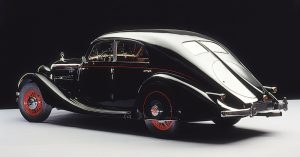


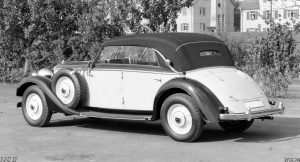
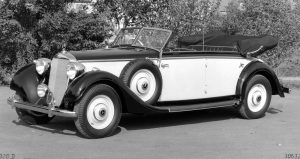
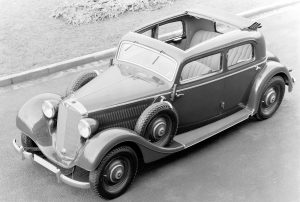
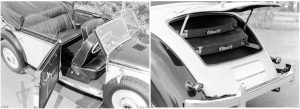

You must be logged in to post a comment.